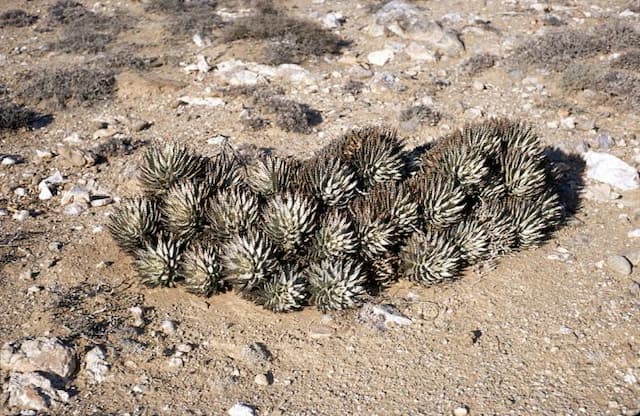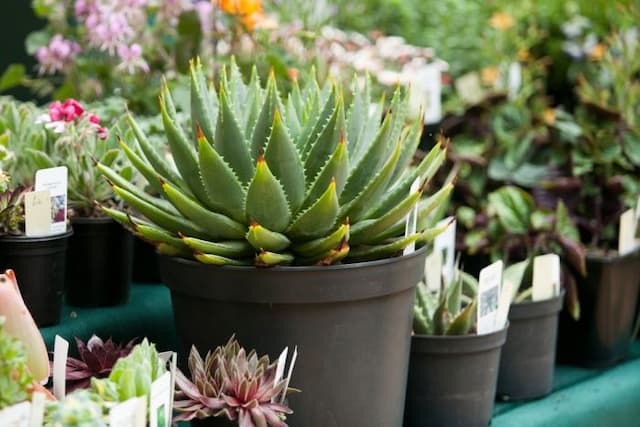Red hot poker Kniphofia thomsonii var. thomsonii 'Stern's Trip'

ABOUT
Kniphofia thomsonii var. thomsonii 'Stern's Trip', commonly known as Red Hot Poker, is a striking perennial known for its distinctive flowering spikes. The appearance of this plant is marked by its vibrant, torch-like floral displays. The flowers bloom in a gradient of fiery colors, usually starting with a warm red at the tip, transitioning through shades of orange, and sometimes ending with yellow or cream at the base. These blossoms are densely packed on tall, upright spikes that rise above the foliage. Red Hot Poker's leaves are long, slender, and grass-like, forming a clump from which the flower spikes emerge. The foliage is typically a rich green, providing a contrasting backdrop that highlights the brilliance of the blossoms. The individual flowers on the spikes are tubular, which commonly attract pollinators like hummingbirds and bees. Their blooming season usually adds a burst of color to the garden when they appear.
About this plant
 Names
NamesFamily
Asphodelaceae
Synonyms
Red Hot Poker, Torch Lily
Common names
Kniphofia thomsonii var. thomsonii 'Stern's Trip'.
 Toxicity
ToxicityTo humans
Red hot poker's toxicity level to humans is generally considered to be low. There is limited information on the specific cultivar Kniphofia thomsonii var. thomsonii 'Stern's Trip', but the Kniphofia genus is not typically associated with severe toxicity in humans. If ingested, however, some people might have a mild reaction, including gastrointestinal discomfort or irritation. It is advised to be cautious and avoid ingesting any part of the plant.
To pets
Red hot poker is not known to be highly toxic to pets, but as with humans, there is limited specific information on the cultivar Kniphofia thomsonii var. thomsonii 'Stern's Trip'. Generally, the Kniphofia genus may cause mild gastrointestinal upset if ingested by pets. Symptoms could include vomiting or diarrhea. It is always best to prevent pets from ingesting the plant as a precautionary measure.
 Characteristics
CharacteristicsLife cycle
Perennials
Foliage type
Evergreen
Color of leaves
Green
Flower color
Mixed
Height
3 feet (0.91 meters)
Spread
2 feet (0.61 meters)
Plant type
Herb
Hardiness zones
Varies
Native area
Africa
Benefits
 General Benefits
General Benefits- Attractive Flowers: Kniphofia thomsonii var. thomsonii 'Stern's Trip', commonly known as Red Hot Poker, produces vibrant, torch-like flowers that add a splash of color to gardens and landscapes.
- Pollinator Friendly: The blooms attract beneficial pollinators such as bees, hummingbirds, and butterflies, supporting local ecosystems.
- Drought Tolerance: Red Hot Poker is known for its ability to withstand periods of drought once established, making it suitable for xeriscaping and water-wise gardens.
- Low Maintenance: The plant typically requires minimal care beyond the initial establishment period, making it a convenient choice for busy gardeners.
- Cold Hardy: It can tolerate cold temperatures, which allows it to be grown in a variety of climates.
- Long Blooming: Red Hot Poker has a lengthy blooming period that extends through multiple seasons, providing long-lasting visual interest.
- Deer Resistance: This plant is not a preferred food source for deer, which can help prevent damage to the garden from browsing animals.
- Architectural Structure: With its tall flower spikes and spiky foliage, it adds architectural interest to garden designs and landscapes.
- Versatile Use: Red Hot Poker works well in perennial borders, as a focal point, in mass plantings, or even as cut flowers for arrangements.
- Soil Adaptability: It can thrive in a variety of soil types, as long as there is good drainage, making it adaptable to different garden conditions.
 Medical Properties
Medical PropertiesThis plant is not used for medical purposes.
 Air-purifying Qualities
Air-purifying QualitiesThis plant is not specifically known for air purifying qualities.
 Other Uses
Other Uses- Decorative Dyeing: The vibrant color of the Red Hot Poker's flowers can be used to create natural dyes for fabrics, offering an eco-friendly alternative to chemical dyes.
- Insect Habitat: Red Hot Poker plants can offer shelter to beneficial insects such as bees and butterflies, promoting biodiversity in your garden.
- Photography Subject: With their striking colors, Red Hot Pokers can be an excellent subject for nature photography, adding visual interest to botanical portfolios.
- Floral Arrangements: The tall and unique flower spikes of Red Hot Pokers can add an exotic touch to cut flower arrangements and bouquets.
- Garden Design: They can serve as architectural plants in garden design, providing vertical interest and a focal point in landscape arrangements.
- Education: Red Hot Pokers can be used in educational settings to teach students about plant biology, pollination, and the importance of plant diversity.
- Erosion Control: Planting Red Hot Pokers on slopes can help prevent soil erosion thanks to their root systems that hold the soil in place.
- Crafts: The dried flower spikes can be used in crafting for making wreaths, ornaments, and other decorative items.
- Culinary Garnish: Although not widely recognized as an edible plant, the flowers of some Kniphofia species may be used as a unique, ornamental garnish for special dishes.
- Climate Indicator: The blooming time of Red Hot Pokers might be observed and recorded to help track changes in local climates and phenological patterns over time.
Interesting Facts
 Feng Shui
Feng ShuiThe Red Hot Poker is not used in Feng Shui practice.
 Zodiac Sign Compitability
Zodiac Sign CompitabilityThe Red Hot Poker is not used in astrology practice.
 Plant Symbolism
Plant Symbolism- Colorful Presence: With its dazzling red to orange shades, the Kniphofia, commonly known as "Red Hot Poker," symbolizes vibrancy and the presence of life's vivid colors, reflecting enthusiasm and excitement.
- Standing Out: As the Red Hot Poker possesses bold and distinctive blooms, it symbolizes standing out from the crowd and being unique or distinctive in one's personal or professional life.
- Attraction: The striking flowers of the Red Hot Poker can symbolize attraction or magnetism, whether it's attracting people, attention, or pollinators like birds and bees in the garden.
- Warmth: The warm colors of this flower echo the warmth of a fire, symbolizing a welcoming environment, comfort, and hospitality.
 Water
WaterRed Hot Poker should be watered deeply, about once a week, allowing the soil to dry out slightly between waterings. During the growing season, this equates to approximately one inch of water weekly, whether through rainfall or manual watering. In winter, reduce the frequency as the plant enters dormancy, but ensure the soil doesn't completely dry out, especially in warmer climates where the ground doesn't freeze. It’s generally better to water Red Hot Pokers in the morning to minimize evaporation and reduce the risk of fungal diseases that could occur from nighttime watering.
 Light
LightRed Hot Poker thrives in a location that receives full sun for the majority of the day, meaning at least six hours of direct sunlight. These plants can tolerate partial shade, but flowering is best in full sun. Therefore, the ideal spot for a Red Hot Poker plant is an area with clear exposure to the sun, away from large trees or structures that might create significant shade.
 Temperature
TemperatureRed Hot Poker plants prefer warm temperatures and are hardy in USDA zones 5 through 9. They can withstand temperatures down to about 10°F but ideally grow in conditions where the temperature doesn't frequently drop below 20°F. During their growth period, daytime temperatures between 60°F and 75°F are ideal for Red Hot Pokers, while cooler night temperatures can help promote flowering.
 Pruning
PruningRed Hot Poker plants benefit from pruning to remove spent flower spikes, which encourages new blooms and prevents self-seeding, if undesired. Deadheading can be carried out throughout the flowering season as needed. In the fall, after flowering has finished and foliage begins to brown, cut the plant back to about 3 inches above the ground. This is also the ideal time to divide overcrowded clumps if necessary.
 Cleaning
CleaningAs needed
 Soil
SoilThe best soil mix for Red Hot Poker (the common name for Kniphofia thomsonii var. thomsonii 'Stern's Trip') is well-draining, loamy or sandy soil that is rich in organic matter. To create an ideal mix, blend two parts garden soil, one part sand, and one part compost or well-rotted manure. The soil pH should be slightly acidic to neutral, ranging from 6.0 to 7.0 for optimal growth.
 Repotting
RepottingRed Hot Poker should be repotted every 2-3 years to refresh the soil and accommodate root growth. It's best done in the spring or early summer when the plant is coming out of dormancy and ready to grow more vigorously.
 Humidity & Misting
Humidity & MistingRed Hot Poker prefers moderate humidity conditions and can tolerate some dry air. It is not particularly humidity-sensitive, but maintaining a level between 40-60% will support its health and flowering.
 Suitable locations
Suitable locationsIndoor
Place Red Hot Poker in a bright spot, away from drafts.
Outdoor
Plant in full sun, well-draining soil, protect from extreme cold.
Hardiness zone
5-9 USDA
 Life cycle
Life cycleThe common name for Kniphofia thomsonii var. thomsonii 'Stern's Trip' is Red Hot Poker, and it typically starts its life cycle as a seed that germinates in warm, moist soil in late winter to early spring. The seedling then develops into a juvenile plant, establishing a rosette of narrow, strap-like leaves as it matures. Over the next few years, the plant grows and expands clump-wise, eventually reaching the flowering stage where tall, distinctive flower spikes emerge above the foliage in the summer, displaying tubular flowers that start off white and transition to orange and finally to red. Pollinators, such as bees and hummingbirds, are attracted to the flowers, aiding in fertilization. After blooming, seeds develop and are dispersed, and the plant may enter a period of dormancy in the colder months, especially in cooler climates. With each subsequent year, the Red Hot Poker will grow larger and produce more flower spikes, continuing its cycle for many years as a perennial plant.
 Propogation
PropogationPropogation time
Spring
Propogation: Kniphofia thomsonii var. thomsonii 'Stern's Trip', commonly known as Red Hot Poker or Torch Lily, is typically propagated by division. This is best done in the spring as new growth is beginning to show, ensuring that the plants have the entire growing season to establish. To propagate by division, carefully dig up the entire clump of the Torch Lily and gently separate the crowns, ensuring that each division has a healthy portion of roots attached. These divisions can then be replanted at the same depth they were previously growing at, spaced at least 18 inches (approximately 45 centimeters) apart to allow enough room for growth. Water well after planting to help establish the new divisions. This method is effective for expanding your collection or renewing older clumps that have diminished flowering.









